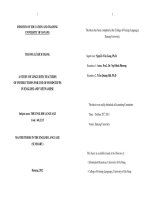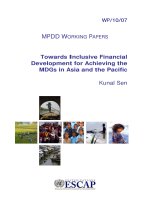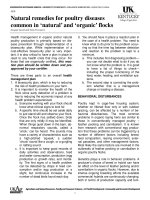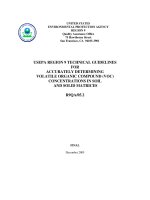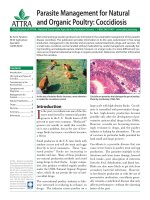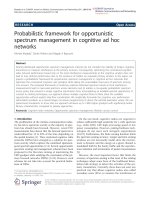Natural remedies for poultry diseases common in ‘natural’ and ‘organic’ flocks potx
Bạn đang xem bản rút gọn của tài liệu. Xem và tải ngay bản đầy đủ của tài liệu tại đây (106.74 KB, 6 trang )
1
AFS-
Health management in organic and/or natural
poultry production is primarily based on dis-
ease prevention through implementation of a
biosecurity plan. While implementation of a
cost-effective biosecurity plan is very impor-
tant, it is also critical to have a plan in place to
react to any health crisis that may occur. For
those that are organically certified, this reac-
tion plan should be written down and pre-
approved by your certifier.
There are three parts to an overall health
management plan
1. A biosecurity plan, which is key to reducing
the risk of health problems on your farm.
2. It is important to monitor the health of the
flock since early detection of a problem is
key to reducing the economic impact of any
health problem experienced.
a. Everyone working with your flock should
know what clinical signs to look for.
b. A specific time should be set aside daily
to just stand still and observe your flock.
Once the flock has settled down, birds
that are only mildly ill may be identified.
When things quiet down in the barn, ab-
normal respiratory sounds, called a
‘snick,’ can be heard. The sounds may
have a variety of characteristics such as
a high-pitched ‘squeak,’ a sudden
‘chuck’ sound like a cough, or a gurgling
or rattling sound.
c. It is important to keep good records of
daily activities and observations, feed
and water consumption, production (egg
production or growth rate), and mortal-
ity. The first signs of a health problem
can be detected by drops in feed con-
sumption and/or egg production or a
slight, but continuous increase in the
number of dead birds found each day.
Natural remedies for poultry diseases
common in ‘natural’ and ‘organic’ flocks
Jacquie Jacob and Tony Pescatore
3. You should have in place a reaction plan in
the case of a health problem. You need to
know what to do prior to the problem occur-
ring so that the time lag between detection
and reaction to the problem is kept to a
minimum.
a. This includes first diagnosing problem—
you can not decide what to do if you do
not know what the problem is. It is good
to have a list of things to check—
including the proper functioning of the
feed, water, heating, and ventilation sys-
tems.
b. The second step is correcting the prob-
lem whether that is a management
change or treating a disease.
BEHAVIORAL DISTURBANCES
Poultry kept in cage-free housing system,
whether on littered floor only or with outdoor
grazing, can be affected by a number of be-
havioral disturbances. The most common
problems in organic laying hens are similar to
those in conventionally managed poultry –
feather pecking and cannibalism. It is known
from research with conventional egg produc-
tion that these problems can be triggered by a
number of different factors including breed,
feed composition, rearing environment, exter-
nal parasites, and other management factors.
Most likely the same factors are involved in the
outbreaks of feather pecking or cannibalism in
organic poultry flocks.
Genetics plays a role in behavior problems. A
producer’s choice of breed or hybrid can have
an affect on the level of feather pecking and/or
cannibalism in organic flocks. However, due to
intense ongoing breeding efforts the available
commercial hybrids are continuously changing,
both in terms of production capacity and tem-
2
perament. It is difficult, therefore, to give any
specific advice regarding the choice of breed
or hybrid. It is important, however, to consider
the temperament of the breed when choosing
your poultry flock.
There has not been a lot of research done on
the use of wound treatments for poultry. Most
commercial poultry producers think in terms of
flock health and not any specific individual bird.
For large operations it is often more cost effec-
tive to cull injured birds. In smaller flocks, how-
ever, care and recovery of such birds may play
a role. In Australia a ‘wound spray’ is commer-
cially available. As the name implies, the spray
is said to assist with healing of a wound on an
injured chicken. While the product is not cur-
rently available in the U.S. it may be helpful to
examine the contents of the Australian prod-
uct. It contains Aloe Vera juice, 3% hydrogen
peroxide, sea salts, copper sulfate, and tea
tree oil.
Sometimes it is necessary to ‘think outside the
box’ when trying to find solutions to bird-to-bird
aggression in a poultry flock. An Australian
company sells a liquid said to ‘keep the peace
between chickens.’ The elixir is made with
Bach Flower Essences which are sold to mod-
ify the mood of humans – aromatic therapy of
sorts.
EXTERNAL PARASITES
Continuous external parasites are those that
spend all of their adult life on the host. Com-
mon continuous external parasites of poultry
are sticktight fleas, chicken body lice, scaly leg
mites, and northern fowl mites. Temporary ex-
ternal parasites are those which feed on the
host but don’t live on the host. Common tem-
porary external parasites of poultry include
fowl ticks (also known as blue bugs), bed
bugs, and chicken mites (also known as red
mites or roost mites).
While there are a number of products ap-
proved for use in Europe, there are only a few
approved for use in the United States. MGK
Co. sells a pyrethrum-containing product
(PyGanic) that can be used in poultry houses
to control insects. The pyrethrum is a botanical
insecticide derived from chrysanthemums.
Old time remedies are making a re-
appearance. Some have been tested in a re-
search setting while others have been tested
on-farm by individual producers with only anti-
dotal information available.
An example of treatment identified in a labora-
tory study is the topical application of garlic to
reduce northern fowl mite infestation. In a re-
search setting, laying hens were individually
sprayed around the vent with either water or
10% garlic juice in water. They were sprayed
continuously each week for three weeks. Topi-
cal application of garlic juice was shown to be
an effective way to decrease northern fowl
mite infestation in laying hens.
An example of antidotal information is the
treatment of scaly leg mites. To combat an in-
festation, one producer obtained good results
by bathing and softening the bird’s feet for a
few minutes in a medium strong solution of po-
tassium permanganate. The skin was then
washed thoroughly, dried, and Vaseline
rubbed on. The treatment was repeated every
three days.
Diatomaceous earth (DE) is believed to be a
natural insect control powder. DE is obtained
from deposits of diatomite which are the fossil-
ized sedimentary layers of tiny phytoplankton
called diatoms. DE is a form of amorphous sil-
ica that can kill insects by desiccation (drying
them out) by absorbing the oily or waxy cuticle
layer during direct contact. When the thin, wa-
terproof layer is lost, the insect loses water and
dies. In addition to its desiccant action, DE
works abrasively to rupture insect cuticles. Dia-
tomaceous earth is OMRI Listed as approved
for organic poultry production.
INTERNAL PARASITES
The most common internal parasite of poultry
is coccidia, a protozoa found almost every-
where poultry are kept. Today, a reasonably
safe and effective vaccine is available for use
in organic poultry production but it must be
3
given early (typically to day-old chicks).
Garlic is used with many animals to prevent
intestinal worm and parasite infestations.
Regular addition of garlic into the drinking wa-
ter is said to control intestinal worms. Garlic is
said to be especially effective when used in
conjunction with worm-repelling plants, such
as wormwood and mint, strategically placed
around the coop.
Chopped or ground pumpkin seeds are said to
be good for the control of tapeworms in laying
hens.
Pasture management for parasite control
There are very few de-worming products avail-
able for use with organic or natural poultry.
Pasture rotation to break the life cycle of
worms is the best management practice to pre-
vent infestation. The choice of pasture crops
has also been shown to have some affect.
A company in Australia is recommending the
use of a number of plants to help with the con-
trol of external and/or internal parasites. For
example:
Wormwood is a medium-sized bush that is
said to have remarkable pest fighting prop-
erties. The chickens will pick at the leaves
and will brush against it, helping to get rid
of any internal and external parasites.
Peppermint is a creeper plant that also of-
fers a terrific scent around the poultry yard.
When planted around the coop area, the
chickens will eat and walk on the leaves
assisting with internal and external parasite
eradication.
Citronella, also known as lemon grass,
forms large clumps of aromatic long leaves
that are said to keep flies, fleas and mites
away from the coop area. The chickens eat
the tips and brush against the bushes when
planted close by.
Additional plants recommended for poultry
pastures:
Dandelion is believed to be a stimulant to
the immune system. In alternative medi-
cine, dandelions are used to treat kidney
and liver disorders of humans. Externally
dandelion is used to treat skin disorders.
Yarrow is a medicinal herb used as an anti-
septic and digestive aid. In alternative
medicine, yarrow is used against colds and
skin irritations.
Sage has been held in high regard through-
out history for its culinary and medicinal
properties. It is believed to have ‘health-
promoting properties.’
Nasturtium is a ground cover creeper which
has beautiful flowers. When planted near
Off-label use is the practice of prescribing pharmaceuticals for a purpose outside the scope of a
drug's approved label, most often concerning the drug's indication. In the United States, the Food
and Drug Administration (FDA) requires numerous clinical trials to prove a drug's safety and effi-
cacy in treating a given disease or condition. If satisfied that the drug is safe and effective, the
drug's manufacturer and the FDA agree on specific language describing dosage, route and other
information to be included on the drug's label.
Drug use is considered off-label when a product is used at a:
different dosage than what is approved on the label
greater or lesser frequency of administration than what is approved on the label
longer or shorter duration of treatment than what is indicated on the label
different route of administration
different species than what is indicated on the label
different age group
different stage of the animal’s production cycle
different dosage form
different formulation
4
the coop area the chickens will eat the juicy
leaves and succulent bright orange or yel-
low flowers helping to rid them of any inter-
nal parasites.
DISEASE CONTROL AND TREATMENT
There is a variety of potentially useful ingredi-
ents that can be added to the feed or drinking
water of a poultry flock to improve production
or to reduce the spread of disease. Some of
these potential ingredients have been tested in
live poultry flocks while others have only been
tested in a laboratory without the use of live
birds. Many of the potential ingredients need to
be more thoroughly tested in live birds and in
real production flocks before they will be com-
pletely embraced by poultry producers. There
are, however, a few products that are OMRI
listed that can be used to prevent or treat
some disease situations of organic poultry
flocks.
A probiotic is a culture of a single bacteria
strain, or mixture of different strains, that can
be fed to an animal to improve some aspect of
its health. Probiotics are also referred to as di-
rect fed microbials (DFM). Probiotics are per-
mitted under the rules specified by the National
Organic Program (NOP) but may not be fed in
amounts above those needed for adequate nu-
trition and health maintenance for the species
and its specific stage in life. Under NOP rules,
probiotics may not be used to stimulate growth
or production. Examples of OMRI listed probi-
otics include PrimaLac
®
from Star Labs Inc,
Avicorr from AgTech Products Inc and The
Poultry Answer
®
from Environmental Care and
Share Inc.
SCD EM Food Grade™ from SCD
®
(Sustainable Community Development) is a
specially formulated food-grade probiotic
‘mother culture’ suitable for human and animal
consumption. It contains a source of live, natu-
rally occurring microorganisms. The product
introduces beneficial and effective microorgan-
isms which work to repopulate the body or liv-
ing system with healthy bacteria. It can be
added to animal feed or can be used as a safe
cleaner for livestock production areas. SCD
EM Food Grade is OMRI listed under Probiot-
ics for health. It can not be offered on a routine
basis and must not be administered in the ab-
sence of illness.
Probiotics are a potential tool for reducing in-
testinal contamination with disease-causing
and foodborne bacteria. They may also be
useful in prevention or treatment of coccidiosis.
Prebiotics are nondigestible carbohydrates
(compounds containing carbon, hydrogen and
oxygen—CHO). Many of these carbohydrates
are short chains of monosaccharides, called
oligosaccharides. Some oligosaccharides are
thought to enhance the growth of beneficial
organisms in the gut, and others are thought to
function as competitive attachment sites for
pathogenic bacteria.
Two of the most commonly studied prebiotic
oligosaccharides are fructooligosaccharides
(FOS) and mannanoligosaccharides (MOS).
FOS can be found naturally in some cereal
crops and onions. MOS is obtained from the
cell wall of yeast. Examples of OMRI listed
MOS products include Agristim
®
from Bioagra
and Agrimos from Lallemand Animal Nutrition.
Safmannan from Lesaffre Feed Additives is a
concentration of yeast hulls obtained via the
breakdown of a yeast by its own enzymes.
Safmann is a source of MOS and is OMRI
listed under yeast.
Organic acids have been used successfully in
pig production for more than 25 years and con-
tinue to be the alternative of choice. While
much less work has been done with poultry,
research indicates that they have a potential
role as an alternative to antibiotics. The antim-
icrobial activity of organic acids is related to
reduction in pH and its ability to dissociate.
The undissociated form of the organic acid
penetrates the cell membrane of bacteria and
disrupt normal cell metabolism. Formic, acetic
and propionic acids, which are organic acids,
have the potential to reduce Salmonella and
Campylobacter colonization in the gut of poul-
try.
Acetic acid is the main component of vinegar.
5
Apple cider vinegar is rich in the vitamins, min-
erals and trace elements found in apples, es-
pecially potassium. In chickens it has been
shown to lower the pH in the digestive tract
which will make an environment less welcom-
ing to pathogens reducing common infections
and increasing resistance to disease. Typical
inclusion levels are 1/8 – 1/4 of a teaspoon of
apple cider vinegar to every 110 ml of water
(or 4.5 - 8.5 teaspoons per gallon). This level
of inclusion will also discourage algae growth.
It should be given for 2-3 days at a time.
Various plant extracts have been studied for
their antimicrobial abilities.
Essential oils are extracted from plants and
possess the smell and characteristic prop-
erties of the plant. They are used chiefly in
the manufacture of perfumes, flavors, and
prescription drugs.
Herbs are flowering plants whose stem
above the ground does not become woody
and persistent. They are valued for the me-
dicinal properties, flavor, scent, etc.
Botanicals are drugs made from a portion of
the plant such as the roots, leaves, barks,
etc.
Research with plant essential oils has
yielded contradicting results, but there is
enough evidence to suggest that they may
have a role as a tool in combating bacterial
diseases in poultry. Thyme, oregano, and gar-
lic appear to have the most potential.
Royal Optimum Solution™, which is OMRI
listed, contains a patented blend of ingredients
derived from essential oils. It basically acts as
a ‘natural’ antibiotic with a broad range of ac-
tivity.
Slippery elm bark powder is a botanical used
in alternative medicine in humans to assist with
tummy upsets, including prevention of morning
sickness often experienced by pregnant
women. It is said to be useful if your chickens
have diarrhea or are off their food.
BFI Innovations has a series of products made
up of botanicals. They sell their products as
tailored for use in game bird feeds, pasture
and/or free range chicken, backyard, and com-
mercial poultry. The products contain a combi-
nation of different natural ingredients. The
combination depends on the particular product.
Some of the natural ingredients the products
contains include:
Aniseed: Digestive enhancer and antimicro-
bial
Cassia: Antiseptic, anti-fungal and anti-
viral; antibacterial, especially against E.
coli.
Cayenne pepper: Appetite stimulant; anti-
septic; digestive enhancement
Garlic: Antimicrobial, antifungal; cholesterol
reduction; circulation benefits
Ginger: Reduces stress; positive effect on
stomach activity; appetite stimulant; antioxi-
dant
Horse radish: Digestive stimulant; antisep-
tic; flavoring properties
Juniper: Gastro-intestinal antiseptic; aids
kidney function; attractive flavor for birds.
ADDITIONAL PRODUCTS AVAILABLE FOR
HEALTH MANAGEMENT OF ORGANIC/
NATURAL POULTRY PROUDCTION
There are a number of products containing dia-
tomaceous earth (DE) that have been ap-
proved for use in organic poultry production.
Rather than being used to control external
parasites, DE can also be used to improve
conditions in a poultry house typically by neu-
tralize ammonia. Reducing ammonia level re-
duces the level of stress to the birds, increases
weight gains and productivity. An example of
an OMRI listed DE product is Barn Fresh
®
from Absorbent Products Ltd. which is contains
diatomaceous earth and a particular clay.
In addition to its uses in external parasite and
ammonia control, DE is also used as a feed
additive. An example of an OMRI listed prod-
uct is Fossil Shell Flour from Perma-Guard Inc
which is made from pure freshwater diatoma-
ceous earth. DE has been reported to absorb
methyl mercury, E. coli, endotoxins, viruses,
some pesticide residues and drug residues.
The pyrethroid insecticide residues may also
bind to DE. The DE product passes un-
changed through the digestive tract.
6
Red Lake Earth
®
DE with calcium bentonite
from Absorbent Products Ltd. Is also OMRI
listed. Red Lake Earth can be added to animal
feeds as an anti-caking agent or as an inert
carrier in a premix. It is said to improve the
flow ability and mix ability of all types of feed.
Ammonia control is important when poultry
flocks are kept indoors, especially in the winter
when there is limited opportunity for use of the
pasture. Additional products are available to
help control ammonia levels, improving the
health and productivity of poultry. Extracts for
the Yucca schidigere plant are often used for
this purpose. An OMRI listed Yucca product is
Biosupreme. The product comes as a liquid
and a powder so can be added to either the
water or feed.
Thermocal Neutralizer from Thermocal
®
Mines
of Idaho also reduces odor but it is added to
the litter rather than fed to the birds. In addition
to reducing odor it absorbs moisture and en-
riches manure. When the enriched manure is
applied to crop fields, it helps reduce soil acid-
ity. Unlike limestone barnlime, Thermocal Neu-
tralizer is not irritating or harmful to people or
livestock. Thermocal Neutralizer contains high
levels of calcium carbonate. It is considered a
management tool rather than a feed additive.
Additional examples of an OMRI listed dietary
sources of calcium carbonate are Penergeti-t
from Planistics Management Ltd. and Royal
Optimum Powder™ from Van Beek Natural
Science LLC. Both products have been shown
to improve appetite, when included in the diet
at the recommended level.
Amaferm
®
from BioZyme Inc. is a dried extract
of a non-pathogenic strain of the fungus Asper-
gillus oryzae. This OMRI listed product can be
added to the feed and is said to enhance
growth and development of microorganisms in
the digestive tract responsible for the break-
down of fibrous feed ingredients.
Culbac
®
Fermentation Product for Animals is
an OMRI listed product from TransAgra Inter-
national Inc. It is obtained by growing the bac-
teria Lactobacillus acidophilus in a special nu-
trient medium. The finished product contains
dried Lactobacillus fermentation product, lactic
acid and roughage.
Levucell
®
SB from Lalleland Animal Nutrition is
an active dry yeast that was selected for its
ability to maintain the balance of intestinal mi-
croflora. It is said to neutralize toxins, bind to
pathogenic bacteria, and reinforce intestinal
wall integrity which allows animals to resist
health challenges. Levucell is OMRI
®
listed un-
der yeast.
XPC Green™ Yeast and XP Green™ Cultures
from Diamond V Mills Inc. are produced by fer-
menting selected liquid and cereal grain raw
ingredients with bakers yeast and drying the
entire culture-media without destroying the
yeast factors, B-vitamins and other fermenta-
tion products. The growth media of XPC Green
consists of processed grain by-products,
roughage products and cane molasses while
the growth media of XP Green consists of corn
gluten feed, hominy feed, wheat middlings, rye
middlings and cane molasses. Both products
are OMRI listed under yeast.
Brand names appearing in this publication are examples only.
No endorsement is intended, nor is criticism implied of similar products not mentioned.
Educational programs of Kentucky Cooperative Extension serve all people regardless of race, color, age, sex, religion, disability, or national origin. Issued in furtherance of Cooperative Extension
work, Acts of May 8 and June 30, 1914, in cooperation with the U.S. Department of Agriculture, M. Scott Smith, Director, Land Grant Programs, University of Kentucky College of Agriculture, Lexing-
ton, and Kentucky State University, Frankfort. Copyright 2011 for materials developed by University of Kentucky Cooperative Extension. This publication may be reproduced in portions or its entirety
for educational and nonprofit purposes only. Permitted users shall give credit to the author(s) and include this copyright notice. Publications are also available on the World Wide Web at
www.ca.uky.edu.
Issued 02-2011
